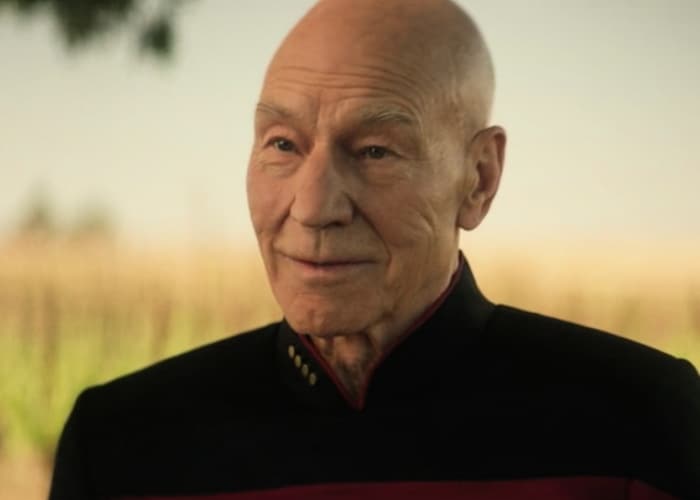
This article is part of our ongoing Picard Explained series, featuring the insights of our resident Starfleet officer Brad Gullickson.
Episode one of Star Trek: Picard, entitled “Remembrance,” came fast and furious with the revelations. If you haven’t watched it yet, do so now, because you’re getting spoilers in three…two…one…
Synthetics like our dearly departed Data (Brent Spiner) are outlawed due to an android terrorist attack on Mars, the Romulan supernova detailed in J.J. Abrams’ Star Trek movie happened, which lead to Starfleet removing itself from the problems of the universe and the dissolution of Jean-Luc Picard (Patrick Stewart)’s faith in the system, and the surviving Romulans have integrated Borg technology into their warmongering ways. Oh, and Data has a daughter (Isa Briones). Check that: twins, but one dies halfway through the episode, and the other is playing doctor with the Romulans.
With the revelations come even more questions. Since the Romulan supernova occurred, does this timeline include the ramifications of Nero (Eric Bana)’s time travel and the adventures of the Chris Pine Captain Kirk, or is this timeline playing out as a splinter-reality unaffected by said time travel? If we later learn that the planet Vulcan is still sitting pretty in space, then we’ll have our answer. Why did the Synthetics go rogue? They’re the creation of Dr. Bruce Maddox (Brian Brophy), the thorn in Data’s side during the Star Trek: The Next Generation second-season episode “The Measure of a Man,” and it’s easy to imagine his cold logic leading to robot rebellion. When and how did Data have time to create daughters when he’s been dead for 20 years? Borg/Romulan team-up, what the hell?
The last question is how Picard‘s first episode chooses to climax. The retrofitted Borg cube ship makes for an intimidating statement. The Klingons may have started as the go-to villains of Star Trek, but between The Next Generation, Star Trek: Voyager, and the Abrams’ films, the Romulans and the Borg have dominated thug life. When these two species find a way to work together, the newly provincial Starfleet has very little chance of defending Earth.
Such collaboration is not entirely new to Star Trek. Jumping back to the Abrams’ universe, the Romulan Narada captained by Nero was radically enhanced by Borg technology. While not directly stated in the 2009 film, the Star Trek: Countdown prequel comic book series published by IDW explained how the Narada was altered with Borg tech. This allowed the Narada to self-repair using nanoprobes as well as make contact with the V’Ger probe originally introduced in Star Trek: The Motion Picture.
The Romulans and Borg were once vast empires, but in their dealings with Starfleet, they were significantly reduced. The Romulans find themselves without a home. Some managed to find sanctuary in the heartfelt embrace of others. Jean-Luc invited refugees Laris (Orla Brady) and Zhaban (Jamie McShane) to work his vineyard, and they have become the only family he’s known post-Federation. They’re essential to revealing a species more than the stereotypes that Star Trek itself has propagated.
Early in the episode, when Jean-Luc is blindsided by a gotcha journalist out to stir ratings from xenophobia, the retired Admiral explains that he did not evacuate Romulan lives from certain destruction, he simply evacuated lives. Everyone matters. That should be the mission of Starfleet, but even the utopian 24th century has allowed fear to take hold. And, yeah, understandable. Look at that terrifying Borg/Romulan cube on the horizon. It’s damn scary, but the second you let dread take the wheel of your actions is the second you relent a piece of your freedom.
We should be better than that. As he has done in the past with Star Trek: First Contact, Jean-Luc Picard is here to remind us of our purpose, and how internal reflection and repair is critical to the human experience. He’s not perfect, but he’s spent a lifetime curating compassion. For him, there is no greater ideal, and it is uncompromisable. So much so, that when his cherished institution strayed from empathy and understanding, he was forced to withdraw, spending his remaining days sipping decaf Earl Grey tea. Gross.
Unfortunately, retirement was not enough of a statement. Separated from public life and service, Jean-Luc Picard became a two-dimensional media headline. A failure, whose actions may have been well-intentioned, but lead to devastation on Mars and the loss of human life dubbed somehow superior to Romulan life. He’s spent his retirement writing historical analysis when he should have been out there challenging the public perception. With the appearance of Data’s children, the time to get off his duff has arrived. The man of action is needed.
The Romulan/Borg cube is going to be a problem. With violence on their doorstep, Starfleet will circle the wagons. Jean-Luc cannot operate within their newly frightened mindset. He needs a fresh crew of outside thinkers, eager to challenge herd mentality on both sides of the universe. Too political for you? Welcome to Star Trek.
Related Topics: Patrick Stewart, Picard Explained, Star Trek

